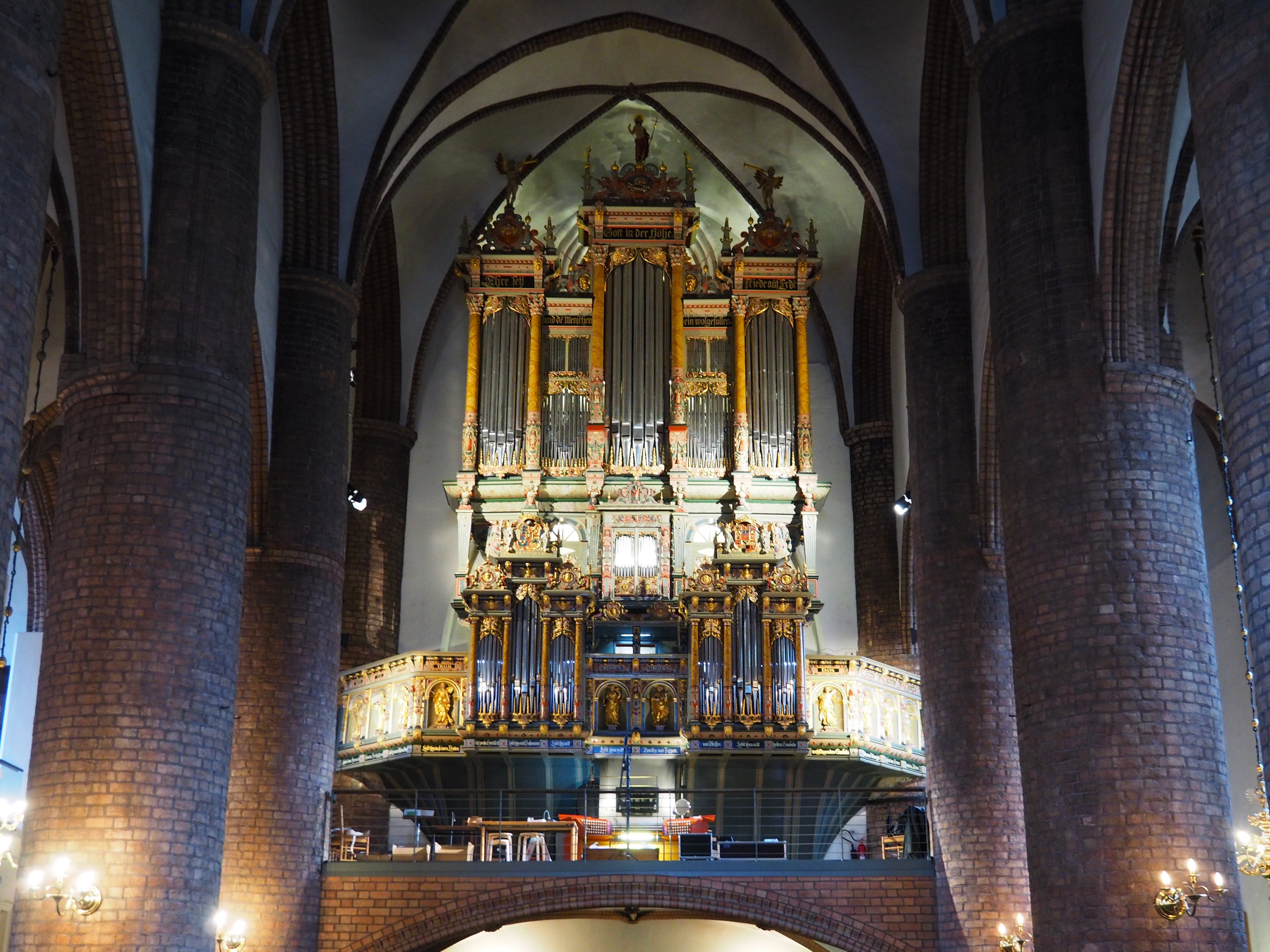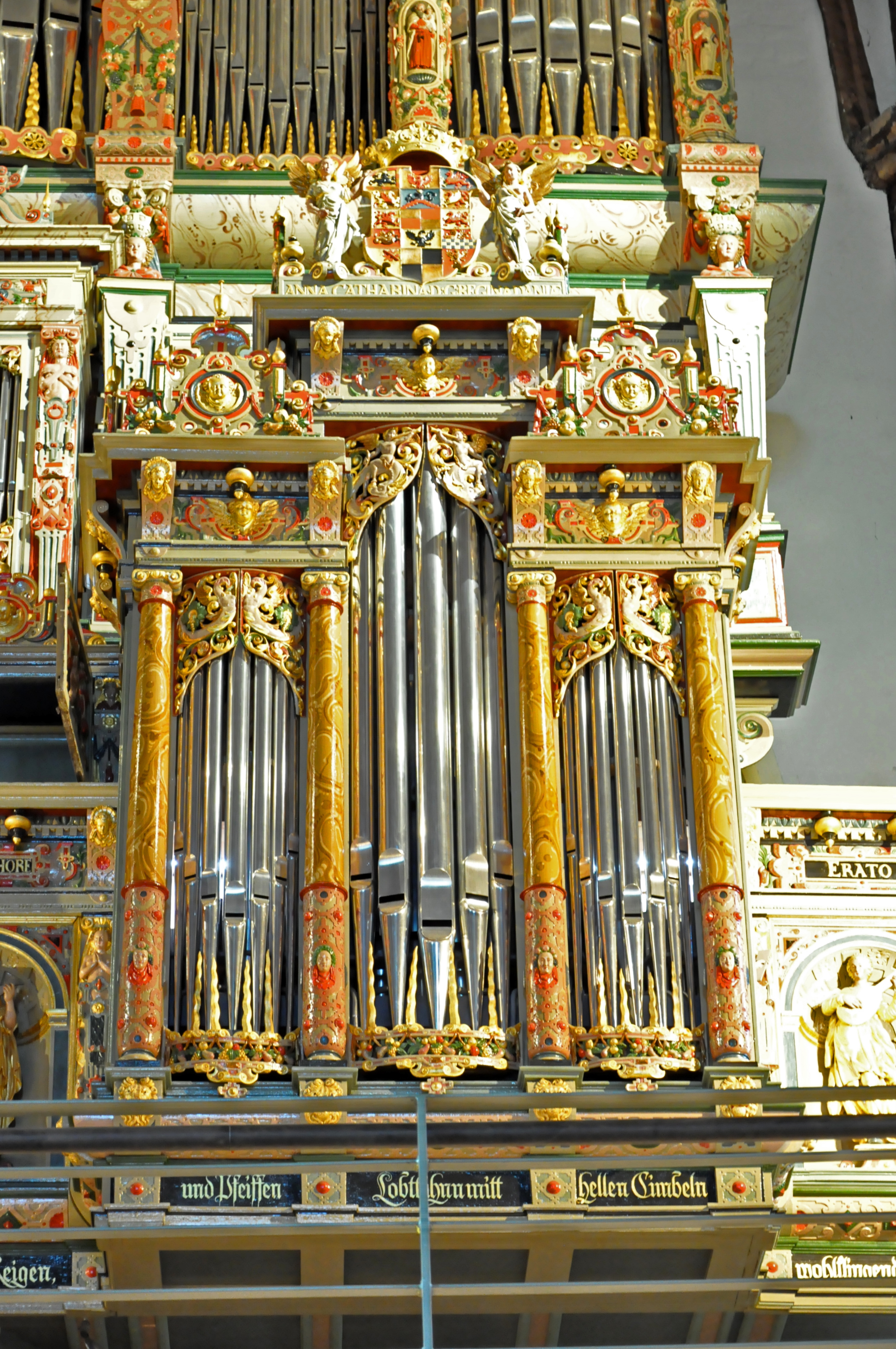Flensburg, St. Nikolai (Symphonic organ)
| Builder | G. Woehl |
|---|---|
| Year | ca. 2009 |
| Period/Style | Symphonic |
| Stops | 68 |
| Keyboards | 5+P |
| Keyaction | tracker/mechanical |
| Tuning | Equal |
The Pipe Organ in St. Nikolai was constructed by renowned organ maker Gerald Woehl, with pipes by Marcussen and Sauer, from 1997 to 2009. The church originally housed a significant Renaissance organ, built by the Danish royal organ maker Nicolaus Maaß from 1604 to 1609 under the command of Danish King Christian IV. The instrument was revamped and expanded into a Baroque organ by Arp Schnitger from 1707 to 1709. The organ's casing, a 15-meter tall, 7-meter wide masterpiece was the work of Heinrich Ringeringk, a Flensburg sculptor. Despite alterations since 1920 that damaged the instrument, it still retains its magnificent aura. Woehl's ambitious project aimed to preserve historical features while introducing modern elements, resulting in two distinct styles of organs behind the restored facade.
The historical casing houses a replica of the Schnitger organ (1709), with its specific characteristics including an old middling pitch and lively 'breathing' wind supply from three traditional wedge bellows for authentically reproducing North German Baroque music. The second organ continues the symphonic style, with features of large romantic organs and a modern temperament. Its 'lung' consists of eight magazine bellows that supply necessary wind, ensuring the organ can range from tender pianissimo to grand symphonic tutti, emphasizing melody.
Since completion, the St. Nikolai now has not only the largest organ in Schleswig but also a unique mix of the Renaissance-style facade, a great North German Baroque organ modelled after Schnitger, and a symphony-romantic instrument. This organ synthesis reflects the instrumental history of the past 400 years at St Nikolai, connecting its historical legacy and modern redesign in a unique manner. The old structure also underwent multiple changes, with a rebuild into the old casing by Marcussen in 1878/79, a new build by W. Sauer in 1922, a remodel by Sauer in 1937/38, followed by a neo-baroque makeover by Kempe in 1957/58. The late Renaissance facade symbolizes the work of the royal organ maker Nicolaus Maaß and the Flensburg sculptor Heinrich Ringerink.
The historical casing houses a replica of the Schnitger organ (1709), with its specific characteristics including an old middling pitch and lively 'breathing' wind supply from three traditional wedge bellows for authentically reproducing North German Baroque music. The second organ continues the symphonic style, with features of large romantic organs and a modern temperament. Its 'lung' consists of eight magazine bellows that supply necessary wind, ensuring the organ can range from tender pianissimo to grand symphonic tutti, emphasizing melody.
Since completion, the St. Nikolai now has not only the largest organ in Schleswig but also a unique mix of the Renaissance-style facade, a great North German Baroque organ modelled after Schnitger, and a symphony-romantic instrument. This organ synthesis reflects the instrumental history of the past 400 years at St Nikolai, connecting its historical legacy and modern redesign in a unique manner. The old structure also underwent multiple changes, with a rebuild into the old casing by Marcussen in 1878/79, a new build by W. Sauer in 1922, a remodel by Sauer in 1937/38, followed by a neo-baroque makeover by Kempe in 1957/58. The late Renaissance facade symbolizes the work of the royal organ maker Nicolaus Maaß and the Flensburg sculptor Heinrich Ringerink.
| Hauptwerk (I) | Positiv (II) | Schwellwerk (III) | Solo/Fernwerk (IV) | Pedal/Fernpedal | |
|---|---|---|---|---|---|
| Principal 16' | Principal 8' | Quintaton 16' | Grand Cornet 6f. | Bordun 32' | |
| Bourdon 16' | Quintadena 8' | Viola di Gamba 8' | Carillon 3f. | Untersatz 16' | |
| Octave 8' | Gedackt 8' | Voix céleste 8' | Quintatön 16' (FW) | Gedackt 16' | |
| Rohrflöte 8' | Octave 4' | Flute traverse 8' | Echobordun 8' (FW) | Octave 8' | |
| Flute harmonique 8' | Flöte 4' | Bourdon 8' | Vox angelica 8' (FW) | Bassflöte 8' | |
| Gambe 8' | Octave 2' | Viola 4' | Echogambe 8' (FW) | Octave 4' | |
| Octave 4' | Sesquialtera 2f. | Flöte octav. 4' | Fugara 4' (FW) | Nachthorn 2' | |
| Nasard 3' | Mixtur 6-8f. | Piccolo 2' | Traversflöte 4' (FW) | Rauschpfeife 2f. | |
| Super Octave 2' | Dulcian 16' | Bombarde' 16 | Mixtur 4-fach (FW) | Mixtur 5-6f. | |
| Mixtur 7-9f. | Baarpfeife 8' | Tromp. harm. 8' | Horn 8' (FW) | Posaune 16' | |
| Cornet 3-5f. | Clairon harm. 4' | Vox humana 8' (FW) | Trompete 8' | ||
| Trompete 16' | Basson-Hautbois 8' | Schalmey 4' | |||
| Trompete 8' | Vox humana 8' | Bombarde 32' | |||
| Trompette 8' | Bombarde 16' | ||||
| Vox humana 8' | Trompette 8' | ||||
| Clairon 4' | |||||
| Groß Gedacktbass 32' (FP) | |||||
| Gedacktbass 16' (FP) | |||||
| Bordun 8' (FP) |
No Video/Audio samples available.
https://organindex.de/index.php?title=Flensburg,_St._Nikolai_(symphonische_Orgel)
 Pipe Organ Map
Pipe Organ Map
